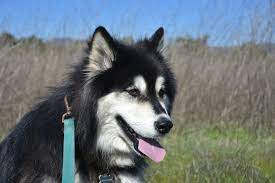Alaskan Sled Dogs, Also Known As Alaskan Dogs, Are Ancient Polar Sled Dogs. Its Name Is Taken From A Tribe Called The Malamute Of The Inuit People Of The Inuit People. Cloth Shore. Adult Alaskan Sled Dogs Have A Quiet, Elegant Temperament And Are Very Loyal To Their Owners, But Unlike Other Breeds In Alaska, They Are Bred For Better Endurance And Not Speed, Because Their Main Purpose Is Pulling Sleds Has A Relatively Strong Working Ability, So It Is Necessary To Give The Alaskan Dog Enough Range Of Motion To Let It Play To Its Heart's Content.
Physical Appearance Characteristics
(1) Eyes: Eyes Oblique, Brown, Almond-shaped, Of Medium Size.
(2) Ears: Triangular In Shape, Medium In Size, Erect, With Slightly Rounded Tips.
(3) Nose: For Other Colors Except Red, The Nose Of The Dog Is Black.
(4) Muzzle: Broad And Tapering From Root To Tip.
(5) Neck: The Neck Is Strong And Slightly Arched.
(6) Back: The Topline Is Straight, Arching Slightly Upward Near The Croup. The Loins Are Full And Muscular, A Long Loin Is A Fault.
(7) Abdomen: The Chest Is Sprawled And The Body Compact, But Not Short.
(8) Legs: The Hind Limbs Are Wide, The Thigh Muscles Are Rich, And The Knee Joints Are Bent. Dewclaws On The Hind Legs Must Be Removed.
(9) Feet: The Toes Are Close Together And Well Arched. There Is A Protective Coat Between The Toes, The Pads Are Thick And Hard, And The Toenails Are Short And Strong.
(10) Tail: The Root Of The Tail Is In A Moderate Position. When Not Working, The Tail Is Curled To The Back, Like
(11) Coat Color: It Can Range From Light Gray To Black And Red. A Solid White Coat Is The Only Acceptable Solid Color Coat.
How To Raise An Alaskan Dog
The Malamute Is Very Demanding Of The Environment, Thanks To Its Waving Flag.
Originated From The Cold Zone, It Is Not Very Heat-resistant And Needs To Maintain A Relatively Cool Environment For A Long Time. This Dog Is Very Active, So Its Living Environment Needs To Be Relatively Spacious, And More Importantly, It Needs To Ensure Sufficient Exercise.
Alaskan Sled Dogs Are Born With Poor Gastrointestinal Function, Especially Puppies, Are More Likely To Suffer From Gastrointestinal Diseases. In Mild Cases, They Have No Appetite, And In Severe Cases, They Suffer From Vomiting And Diarrhea.
The Coat Must Be Combed Regularly From Childhood. Common Tools Include Scraping Brush, Needle Brush, Coarse-toothed Comb, And Rake Comb. The Main Point Is To Regularly Comb The Hair On Both Sides Of The Abdomen.
The Hair Should Be Combed Once In The Morning And Evening, And The Hair Should Be Combed For 5 Minutes Each Time.
Pay Attention To The Order Of Combing: Start From The Neck, From Front To Back, And From Top To Bottom, That Is, From The Neck To The Shoulders, Then The Back, Chest, Waist, Abdomen, Hindquarters, Then The Head, And Finally It Is The Limbs And Tail. During The Combing Process, One Side Should Be Combed And Then The Other Side Should Be Combed.
Combing Method: Combing Should Be Done Quickly In The Direction Of The Hair. When Combing Long-haired Dogs, Many People Only Comb The Long Hair On The Surface And Ignore The Fine Hair Below. The Undercoat Of Dogs Is Soft And Dense. If It Is Not Combed For A Long Time, It Will Form Tangles And Even Cause Eczema, Psoriasis Or Other Skin Diseases. Therefore, When Combing A Long-haired Dog, It Should Be Combed Layer By Layer, And The Long Hair Should Be Turned Up, And Then The Undercoat Should Be Combed.
Types Of Combs: Hair Brushes, Flexible Wire Brushes, And Long, Sparse Metal Combs. A Brush Can Only Fluff Up The Ends Of The Long Hairs, But Not The Finer Hairs. When Combing Long-haired Dogs, Hair Brushes, Elastic Wire Brushes And Long And Sparse Metal Combs Should Be Used Together.



Comments
Post a Comment